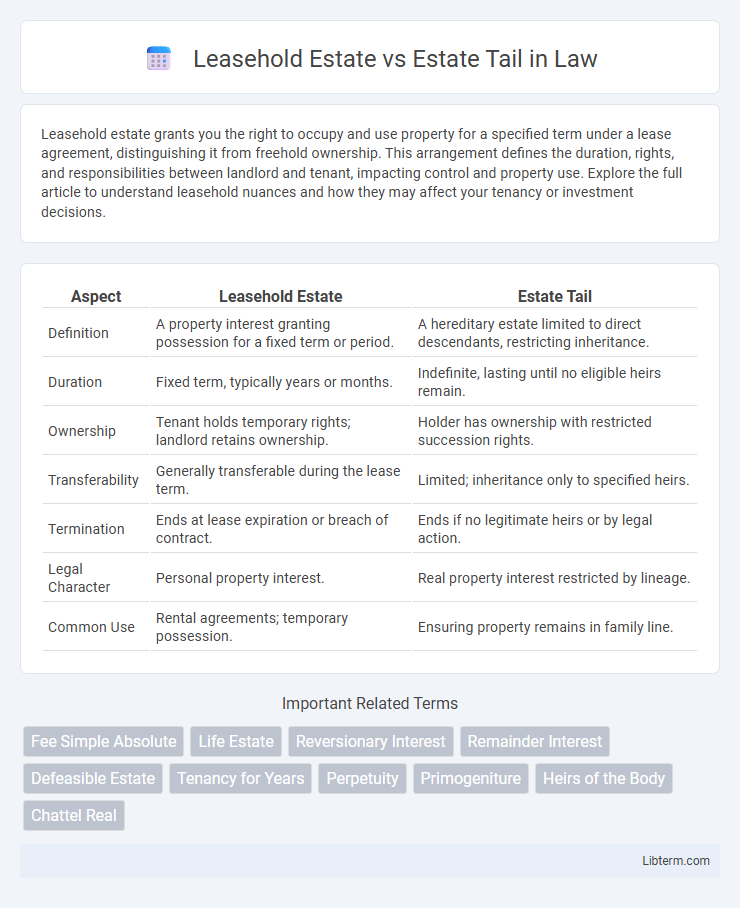Leasehold estate grants you the right to occupy and use property for a specified term under a lease agreement, distinguishing it from freehold ownership. This arrangement defines the duration, rights, and responsibilities between landlord and tenant, impacting control and property use. Explore the full article to understand leasehold nuances and how they may affect your tenancy or investment decisions.
Table of Comparison
| Aspect | Leasehold Estate | Estate Tail |
|---|---|---|
| Definition | A property interest granting possession for a fixed term or period. | A hereditary estate limited to direct descendants, restricting inheritance. |
| Duration | Fixed term, typically years or months. | Indefinite, lasting until no eligible heirs remain. |
| Ownership | Tenant holds temporary rights; landlord retains ownership. | Holder has ownership with restricted succession rights. |
| Transferability | Generally transferable during the lease term. | Limited; inheritance only to specified heirs. |
| Termination | Ends at lease expiration or breach of contract. | Ends if no legitimate heirs or by legal action. |
| Legal Character | Personal property interest. | Real property interest restricted by lineage. |
| Common Use | Rental agreements; temporary possession. | Ensuring property remains in family line. |
Introduction to Leasehold Estate and Estate Tail
Leasehold estate grants a tenant possession and use of real property for a specified period under a lease agreement, without ownership rights to the land itself. Estate tail is a type of hereditary estate that restricts inheritance to direct descendants, ensuring the property remains within a particular family line. Both legal concepts regulate property interests but differ significantly in duration, transferability, and ownership rights.
Definition of Leasehold Estate
A leasehold estate is a property interest that grants a tenant the right to use and occupy land or real estate for a specified period under a lease agreement, without transferring ownership. Unlike an estate tail, which is a form of inheritable freehold estate limiting succession to direct descendants, a leasehold estate terminates upon expiration or breach of lease terms. This distinction affects tenants' rights and obligations, with leasehold estates offering temporary possession and estates tail providing long-term hereditary ownership.
Definition of Estate Tail
Estate tail, also known as fee tail, is a form of hereditary property ownership restricting inheritance to direct descendants of the original grantee. Unlike a leasehold estate, which grants possession for a specified term without transfer of ownership, an estate tail limits conveyance and sale rights, ensuring the property remains within a particular family lineage. This legal mechanism historically preserves family estates by preventing the alienation or fragmentation of inherited land.
Key Differences Between Leasehold Estate and Estate Tail
Leasehold estate grants the tenant possession of property for a fixed term under a lease agreement, without transferring ownership rights. Estate tail is a hereditary freehold estate that limits inheritance to the direct descendants of the original grantee, ensuring the property remains within the family lineage. The key differences lie in duration--leasehold is temporary and non-inheritable, while estate tail is perpetual and restricts ownership succession.
Historical Background of Leasehold Estate
The leasehold estate originated during medieval England as a legal arrangement allowing tenants to hold property rights for a fixed term without owning the land outright. This system emerged to accommodate the feudal society's hierarchical structure, where landowners granted temporary possession in exchange for rent or service. Over time, leasehold estates evolved into formalized contracts protecting tenant rights while preserving the landlord's ultimate ownership.
Historical Evolution of Estate Tail
Estate tail, originating in medieval England, was designed to keep land within a family lineage by restricting inheritance to direct descendants, preventing land from being sold or inherited outside the bloodline. Over centuries, reforms such as the Fines and Recoveries Act 1833 gradually abolished or converted estates tail into fee simple estates, reflecting shifts toward greater land marketability and flexibility. Leasehold estates emerged alongside, offering tenants temporary possession rights without ownership, contrasting the hereditary and restrictive nature of estate tail.
Legal Rights of Holders: Leasehold Estate vs Estate Tail
Leasehold estates grant tenants exclusive possession and use of property for a specified term, with rights limited by the lease agreement and no ownership interest, reverting to the landlord upon expiration. Estate tail provides inheritable ownership restricted to lineal descendants, ensuring the property remains within the family bloodline without the ability to sell or transfer outside this lineage freely. Legal rights in leasehold estates emphasize possession and use restrictions, while estate tail rights focus on perpetuating ownership within a defined hereditary succession.
Transferability and Inheritance
Leasehold estates grant tenants the right to use property for a specified term, with transferability often limited by lease provisions and typically non-inheritable beyond the lease period. Estate tail, a form of hereditary freehold estate, ensures property passes exclusively to direct descendants, restricting sale or transfer outside the bloodline, thereby preserving lineage inheritance. Transferability of leasehold estates depends on lease terms, whereas estate tail estates inherently limit alienation to maintain family succession.
Modern Relevance and Application
Leasehold estates remain highly relevant in modern real estate, offering tenants temporary property rights that facilitate residential and commercial leasing arrangements. Estate tails, although largely abolished or heavily restricted due to their inflexibility, influence contemporary property law by highlighting the shift towards fee simple ownership and promoting marketable title concepts. Understanding the distinction aids in navigating property inheritance, transfer restrictions, and long-term investment strategies in current legal frameworks.
Conclusion: Choosing Between Leasehold Estate and Estate Tail
Choosing between a leasehold estate and an estate tail hinges on factors like duration, inheritance rights, and transferability. Leasehold estates provide temporary property rights for a specified term, suitable for limited use without long-term ownership. Estate tail grants inheritance-restricted ownership, ensuring property remains within a family lineage, ideal for preserving generational wealth and control.
Leasehold Estate Infographic

 libterm.com
libterm.com